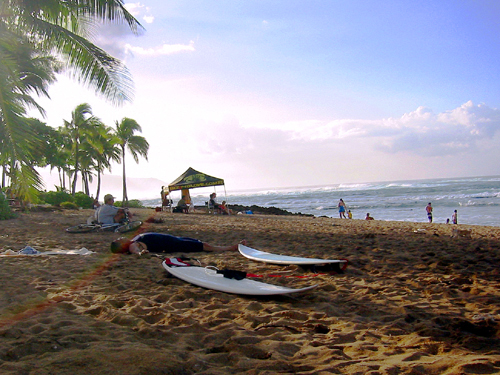12.27.2004 | A Wahoo

We're just back from Hawaii.
If someone were to ask me how the trip went, I think I wouldn't have much to say about it in touristic terms. The trip went by so fast.
I'd been so busy that preparing to leave was like trying to stop a fast, heavy train. Worse, so much of that activity was engendered and embellished directly from the emotional cache; there was no emptying it short of turning it off, which, though desirable, was not possible.
There were Xmas duties: presents to buy and people to see. Loose ends needed tying at the jobs. I vowed to have a clean house before I left.
Neither of us slept the night before the flight and we left at 4:30 in the morning, lesser-brained but ready. Andrew had called a towncar. It was beautiful and black, armored in shine and length but pillowy on the inside. It cost the same as taking a heathen taxi.
We Hotwired accommodations in Waikiki, which we ultimately didn't see much of: We slept much those first three days, shopping and visiting family in between sleeps. There was too much shopping, all of it necessary but draining. I keep learning that I don't like shopping. It's stressful and tiring and worries the bank account—but that's old news.
Most things on Oahu are packaged plastic tourist crap. This includes the overpriced and cheap chain restaurants and Hawaiian culture at large. We took a hint from hipstomp and visited the Wailana Coffeehouse for most of our first meals of the day. Though a greasy spoon, the place satisfied the need for being out of commercial homogeneity. The old Asian ladies waiting on us had the look of establishment. The seats cushions were torn and ragged. An ancient Asian couple crawled in each day while we were there, precarious and moribund and rasping orders at the waitresses. We drank our weak coffee and let the fried morsels slip over the tongue in a pleasant unctuousness as we watched the color-coded tourist trolleys depart Waikiki for the rapture of high-priced prefab destinations.
I did get to see the U.S.S. Arizona Memorial, which has always been on my list. You fly over it if you land in Honolulu. You see from the air the blossom-shaped harbor and the gray slivers of ships moored there. You can see the memorial too, stark white and geometrical—inorganic.
The visit is free. You have to watch an educational film about the attack before you can see the ship. The film is conservative, providing just the facts. Surprisingly, there's amazing footage of the attack and of the destruction of the Arizona. Even though I know a fair amount about the events of that day and the controversies surrounding it, I didn't know that due to the fear of sabotage the fighters stationed at the islandís military airfields were parked wingtip to wingtip on the runway. When the attack came, there was no room to take off.
After the film, the park rangers put you on a boat and putt you out across the harbor to the memorial. Buoys mark the bow and stern of the ship. The memorial itself straddles the wreck amidships. The No. 3 turret rises rusty and decayed above the tide line, as do one or two other shapes. The rest of the deck's topography lies just below the surface, aquamarine and rusty and covered in emerald marine flock. Oil makes its way to the surface regularly and the slow water stretches and warps its rainbows. The ranger said that the ship had just been filled with some millions of gallons of oil before the attack. Currently, a few pints of oil are lost each day. It will take over 100 years to deplete the store. But that's if the structure holds, which it won't.
One end wall of the memorial lists all of the sailors on the ship who died in the explosion and sinking. A little marble box below and to the left marks the names of the sailors who survived the attack who have subsequently died and were interred there. These names were most poignant for me. How did they survive, and what was it like for them to live as so few? How many more are left?
Traveling to Hawaii with Andrew is not a vacation, it's a visit. For me, Hawaii is all beach, jewelled waters, and fragrance. For him, it's subsistence, family, and memory. Everything is prosaic to him; all is fantasy to me. It's not an overly difficult difference, but it demands compromise all the sameóin both directions. Too much time in malls for me. Maybe not enough time for both of us, regardless.
Island life seems a lot like living on an Indian reservation. It is an economy of exploitation with few avenues up or out. The time of opportunity has passed. Those of productive age just prior to, during, and after the war seem to own most of the land and the businesses that comprise the local economy. Subsequent generations rent from or work for these people with no chance of achieving ownership except, perhaps, by inheritance.
The North Shore is my favorite of the places we visited. The waves were HUGE! Just like you always hear they are. They were a light jade and shiny and unconquerable. All but the lusty surfers hugged the sand, and the surfers out there on the swells were only specks of inconsequence.
We caught the end of a surfing competition. The time limit and play-by-play made watching the occasional flight down the inside of a wave a lot more interesting than it otherwise would've been. On the beach around us were sunbroiled surfers waiting for the waters to open. In the shallows, children and one middle-aged woman surfed scraps.